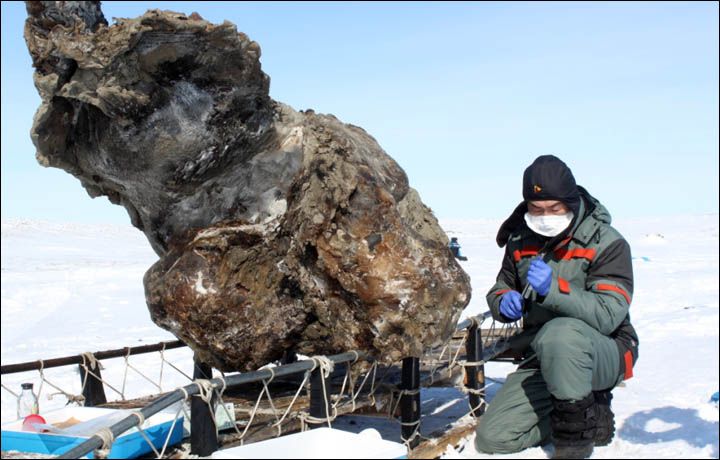
Despite the recent discovery of a stunningly preserved mammoth, the odds of scientists using it to clone a real-life mammoth anytime soon are still low, experts say.
"To clone a mammoth by finding intact cells — and, more importantly, an intact genome — is going to be exceptionally difficult, likely impossible," said Love Dalén, a paleogeneticist at the Swedish Museum of Natural History. "Finding this mammoth makes it slightly less impossible."
Dalén is referring to the amazingly preserved mammoth remains found recently in the icy tundra on an island off the coast of Siberia. Some of the tissue was locked beneath the ice, and when researchers struck it with a pick, blood came flowing out, they said. [See Images of the Preserved Mammoth]
Even tissue that looks as juicy and fresh as a steak, however, can be damaged on the cellular level. That would mean very little useful DNA (the molecules that carry the instructions for life), could be extracted, the researchers said.
Stunning find
Outside researchers haven't examined the tissue and blood that was reportedly preserved in this 10,000-year-old mammoth. but Dalén's conversations with the research team suggest the fossilized beast is in incredibly good shape, he said.
"Every mammoth that has ever been found — it's either its bones or dried tissue and skin or pieces of hair, so to find a piece of frozen mammoth that's so well preserved that there's blood inside is pretty amazing," Dalén said. "From a DNA standpoint, it might be the most well-preserved specimen ever found."
Sign up for the Live Science daily newsletter now
Get the world’s most fascinating discoveries delivered straight to your inbox.
Holy Grail
Because flash freezing could preserve the cells, and possibly their genetic information, everyone in the field is searching for the Holy Grail: a mammoth that fell into a frozen lake, which then immediately froze overnight and stayed perennially frozen for 10,000 years, said Hendrik Poinar, an evolutionary geneticist at McMaster University in Canada.
The chances of finding such a perfect specimen are incredibly slim, Poinar said.
Even if a mammoth were buried in ice at the time of discovery, it wouldn’t be clear how many times the fossil had thawed and refrozen over the millennia, he added.
Past mammoth discoveries have looked very good on the outside — even shooting out what initially looked like blood — only to later be found to have heavily damaged cells that contain unusable DNA.
"When you take [samples] back to the lab, you realize that they're pretty heavily degraded," Poinar told LiveScience.
For cloning, intact DNA is needed, as the process requires replacing the DNA in an elephant egg with a mammoth's genome, then gestating the egg inside an elephant.
But time and harsh weather conditions inexorably degrade DNA, splitting it up into millions of tiny snippets that are extremely difficult to piece together. For instance, a 2012 study found that in bone, half of the chemical bonds in DNA break down within 521 years after death, and the genetic material degrades completely by 6.8 million years.
Elephant in disguise?
If the white blood cells — or more likely, tissues — from the recently discovered mammoth are in fairly good condition, then there may be longer intact DNA snippets, which should be easier to piece together, Poinar said.
Either way, the mammoth genome would probably be reconstructed by using the elephant genome as the blueprint.
By comparing genomes, researchers would try to identify the key genes that create distinctive traits — such as body size, the tusks and shaggy coats of the extinct creatures — and tack those in to the elephant genome, Poinar said.
Cloning based on that blueprint may result in a rather odd creature: something that looked, on the outside, like a mammoth, but was basically an elephant in disguise.
Is cloning a mammoth a worthy endeavor for science? "I hope the science moves slow enough in this case that we can actually have that discussion," Poinar said.
Follow Tia Ghose on Twitterand Google+. Follow LiveScience @livescience, Facebook & Google+. Original article on LiveScience.com.

Tia is the managing editor and was previously a senior writer for Live Science. Her work has appeared in Scientific American, Wired.com and other outlets. She holds a master's degree in bioengineering from the University of Washington, a graduate certificate in science writing from UC Santa Cruz and a bachelor's degree in mechanical engineering from the University of Texas at Austin. Tia was part of a team at the Milwaukee Journal Sentinel that published the Empty Cradles series on preterm births, which won multiple awards, including the 2012 Casey Medal for Meritorious Journalism.











